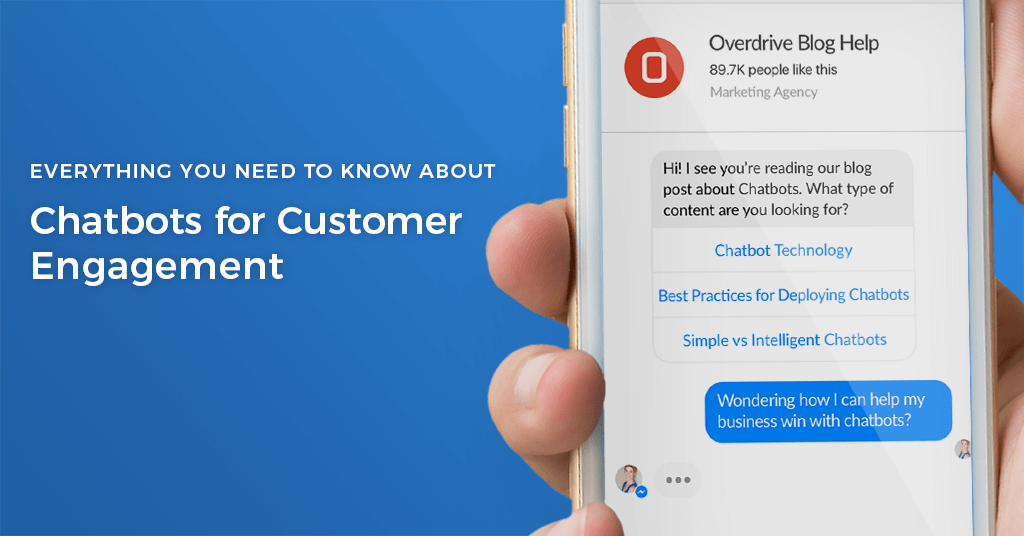
Chatbots 101
When you think of good customer service, what comes to mind? Effective communication between employees and customers is certainly one example. As technology is advancing, brands are finding effective ways to engage with their audience. Chatbots are one example that companies have been experimenting with, and many have found success with the messaging platform. The global chatbot market is expected to reach $1.23 billion by 2025, not surprisingly, with artificial intelligence constantly evolving into our day-to-day lives. Let’s dive into Chatbot 101.
Simple Chatbot
Chatbots that provide weather updates, fulfill orders, make reservations, search for and track flights, provide daily news topics, and more. They help customers in a timely manner and find solutions no matter where they are, and what device they use. You can use and deploy chatbots on almost any interface including your website, mobile devices, social media platforms, messaging apps, voice response, and SMS.
Intelligent Chatbot
The main goal of intelligent chatbots are to solve a user’s problem. They are programmed to learn from previous conversations so they can develop over time, and convert useful information and store it in a correct manner.
Enterprise Level Chatbots
Chatbots have the ability to handle internal processes, such as data entry, scheduling, virtual assistant tasks, and even payment between vendors and suppliers. This is shaking up the B2B world, and will continue to advance as time goes on.
When Is A Human Required?
A chatbot should escalate to a live agent when:
1.) The chatbot isn’t giving satisfactory response to the customer.
2.) An unexpected situation occurs, and the live agent can better cater to the situation if a problem arises.
3.) Technical error occurs (AI and NLP isn’t always going to perform perfectly).
How Does My Business Win With Chatbots?
Sales and marketing: This is an era of humans wanting immediate service. With chatbots, there is opportunity for individualized attention, and the window is open for sales, consumer loyalty, and overall personal connection with your business. The integration of chatbots can help push customers through the sales funnel.
Customer service and support: Implementing chatbots into your brand strategy can provide a more seamless customer experience. A consumer can get their questions answered more quickly and accurately by engaging in conversation with a chatbot, rather than looking for the answer on the website. Chatbots can also send information regarding your company, products, and services.
Employee assistance: By adding bots to the picture, employee efficiency can significantly improve. To name an example, employees can give feedback to the bot instead of filling out forms. Insight can be sorted as positive or negative from the conversation and overall boost workplace efficiency.
Customer insight: Engaging one-on-one with customers is a great way to gather consumer insights. By simply tracking purchasing patterns, questions that are frequently asked, or common problems/issues customers face, you can analyze this to improve your overall strategy.
Chatbot Technology
Chatbots are trained with AI technology to translate input data into output value. With this given data, it analyzes and forms context to the relevant data to respond with written prompts. This is also referred to as “deep learning”, where the chatbot takes new information and data without any prior knowledge, then converts and stores this data. NLP (natural language processing) allows them to communicate and give human-like conversations to the person on the other end.
Best Practices For Deploying Chatbots
- Respect form factors
- Stick to chat-like interfaces
- Make it natural
- Be contextual and to the point
- Align with your brand
- Use first person
- Make it succinct
- Don’t ignore the humans
- Insist on out-of-the-box industry knowledge
- Make maximum use of chatbot conversations
What To Look For In A Chatbot Solution
Purpose-built: The platform should have a goal, such as selling the product, answering questions, pay invoices for your business, as long as there is a goal in place for the chatbot.
Extensive industry experience: Do research to find the best platform for your company, that has the necessary experience needed to implement chatbots into your strategy.
Data control: The platform should learn over time and grow with the data applied.
Intent prediction: Operate efficiently from taking past data and extracting it to provide responses.
Conversation: Seamless communication from bots to customers to gather data and provide solutions.
Learning: Choose a platform that can take knowledge from chat logs, knowledge bases, CRM, emails, and more.
Escalation: When the chatbot is unable to give a satisfactory answer, there is a human hand-off in place to handle the situation.
Data analysis: Monitor conversations between users so the bot detects the customer journey, and leverage data to help user engagements.
Looking Into The Future
Artificial intelligence is rapidly growing and used across many industries, including the marketing world. There’s still much work to be done, as the technology behind chatbots will develop, advance, and grow over time. The accuracy of chatbots is still not up to par in terms of understanding questions and context with humans. We’re certainly excited to see where chatbots will take us in the coming years.




